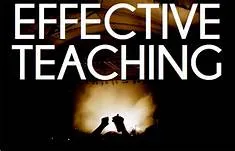Twelve distinctive behaviors comprise an inventory of qualities found in effective teachers. This list is based on one developed by Harry Murray at the University of Western Ontario. Specific sub behaviors, for each inventory’s behavior, are defined.
- Enthusiasm – use of non-verbal behavior to solicit student attention and interest
- Clarity – method used to explain or clarify concepts and principles.
- Interaction – techniques used to foster student’s class participation.
- Organization – ways of organizing or structuring subject matter.
- Pacing – rate of information presented, efficient use of time.
- Disclosure – explicitness concerning course requirements and grading criteria.
- Speech – characteristics of voice relevant to classroom teaching.
- Rapport – quality of interpersonal relations between teacher and students.
- Relevance – bridges made between course content, processes and the world.
- Learning Centered – focuses squarely on student learning and mastery.
- Flexibility – openness to change; diverse ways of looking at, approaching material.
- Leadership – models civil behavior, intellectual rigor and respect for diversity.
1. ENTHUSIASM: use of non-verbal behavior to solicit student attention and interest
- Speaks in a dramatic or expressive way.
- Moves about while lecturing or presenting.
- Gestures with hands or arms, yet avoids distracting mannerisms.
- Maintains eye contact with students.
- Walks up aisles beside students.
- Avoids reading lecture verbatim from prepared notes or text.
- Smiles while teaching.
2. CLARITY: method used to explain or clarify concepts and principles
- Gives several examples of each concept.
- Uses concrete everyday examples to explain concepts and principles.
- Defines new or unfamiliar terms.
- Repeats difficult ideas several times.
- Stresses most important points by pausing, speaking slowly, raising voice, etc.
- Uses graphs or diagrams to facilitate explanation.
- Points out practical applications of concepts.
- Answers students’ questions thoroughly.
- Suggests ways of memorizing complicated ideas.
- Writes key terms on blackboard or overhead screen.
- Explains subject matter in familiar colloquial language.
3. INTERACTION: techniques used to foster students’ class participation
- Encourages students’ questions and comments during class.
- Avoids direct criticism of students when they make errors.
- Praises students for good ideas.
- Asks questions of individual students.
- Asks questions of class as a whole.
- Incorporates students’ ideas into presentation.
- Presents challenging, thought-provoking ideas.
- Uses a variety of media and activities in class.
- Asks rhetorical questions.
- Listens and responds to students’ contributions and learning.
4. ORGANIZATION: ways of organizing or structuring subject matter
- Uses headings and subheadings to organize presentation.
- Puts outline on blackboard or overhead screen.
- Clearly indicates transition from one topic to the next.
- Gives preliminary overview at beginning of class.
- Explains how each topic fits into the course as a whole.
- Begins class with a review of topics covered last time.
- Periodically summarizes points previously made.
5. PACING: rate of information presentation, efficient use of time
- Digresses rarely from major theme.
- Covers the important material in class sessions.
- Asks and confirms if students understand before proceeding to next topic.
- Sticks to the point in answering students’ questions.
6. DISCLOSURE: explicitness concerning course requirements and grading criteria
- Advises students on how to prepare for tests or exams.
- Provides sample exam questions.
- Tells students exactly what is expected of them on tests, essays or assignments.
- States objectives of each meeting.
- Reminds students of test dates or assignment deadlines.
- States objectives of course as a whole.
7. SPEECH: characteristics of voice relevant to classroom teaching
- Speaks at appropriate volume.
- Speaks clearly.
- Speaks at appropriate pace.
- Leaves pauses in speech silent and avoids “um” or “ah”.
8. RAPPORT: quality of interpersonal relations between teacher and students
- Addresses individual students by name (to the extent possible in larger classes).
- Announces availability for consultation outside of class.
- Offers to help students with problems.
- Shows tolerance of other points of view.
- Talks with students before or after class.
- Acknowledges diversity in learners and their culture.
9. RELEVANCE: bridges made between course content, processes and the world
- Provides broad (holistic) context for specific learning concepts and skills.
- Integrates materials (examples, cases, simulations) from “real world”.
- Bridges specific learning concepts and skills to learners’ experiences.
- Provides learners with access to external sources and experts to validate learning.
- Provides opportunities for learners to apply learning to external world.
- Provides opportunities for learners to bring external learning into the curriculum.
10. LEARNER CENTERED: focuses squarely on student learning and mastery
- Focuses on learning outcomes and growth, not content taught.
- Pre/during/post assessments used to ensure learning.
- Instructor elicits student discovery and construction of knowledge.
- Learners have some control over learning process.
- Active, collaborative, and cooperative learning favored over passive learning.
- Instructors are primarily designers and coaches.
- Instructors and learners work in teams where appropriate.
- Learners are empowered to take over their own learning.
- Motivates learners by supporting their self-efficacy – ability to succeed.
11. FLEXIBILITY: openness to change and diverse ways of looking at, approaching material
- Teaching appeals to different learning styles.
- Awareness of inter-subjective construction of knowledge.
- Appreciation of multiple perspectives and intellectual curiosity.
- Willingness to “give” responsibility of learning to learners where appropriate.
12. LEADERSHIP: models civil behavior, intellectual rigor and respect for Diversity
- Models and requires a learner’s behavior that supports teaching and learning.
- Models intellectual engagement with ideas, concepts and materials.
- Provides intellectual challenge for all levels of learner abilities.
- Demonstrates respect for diversity and requires similar respect in classroom.

